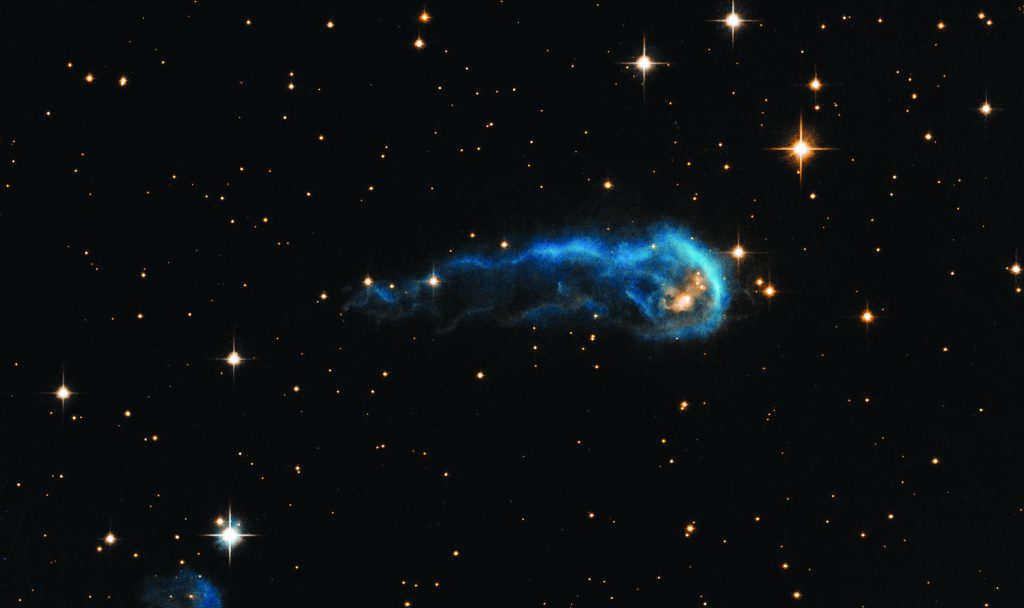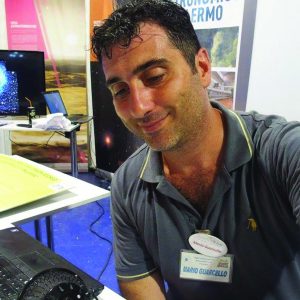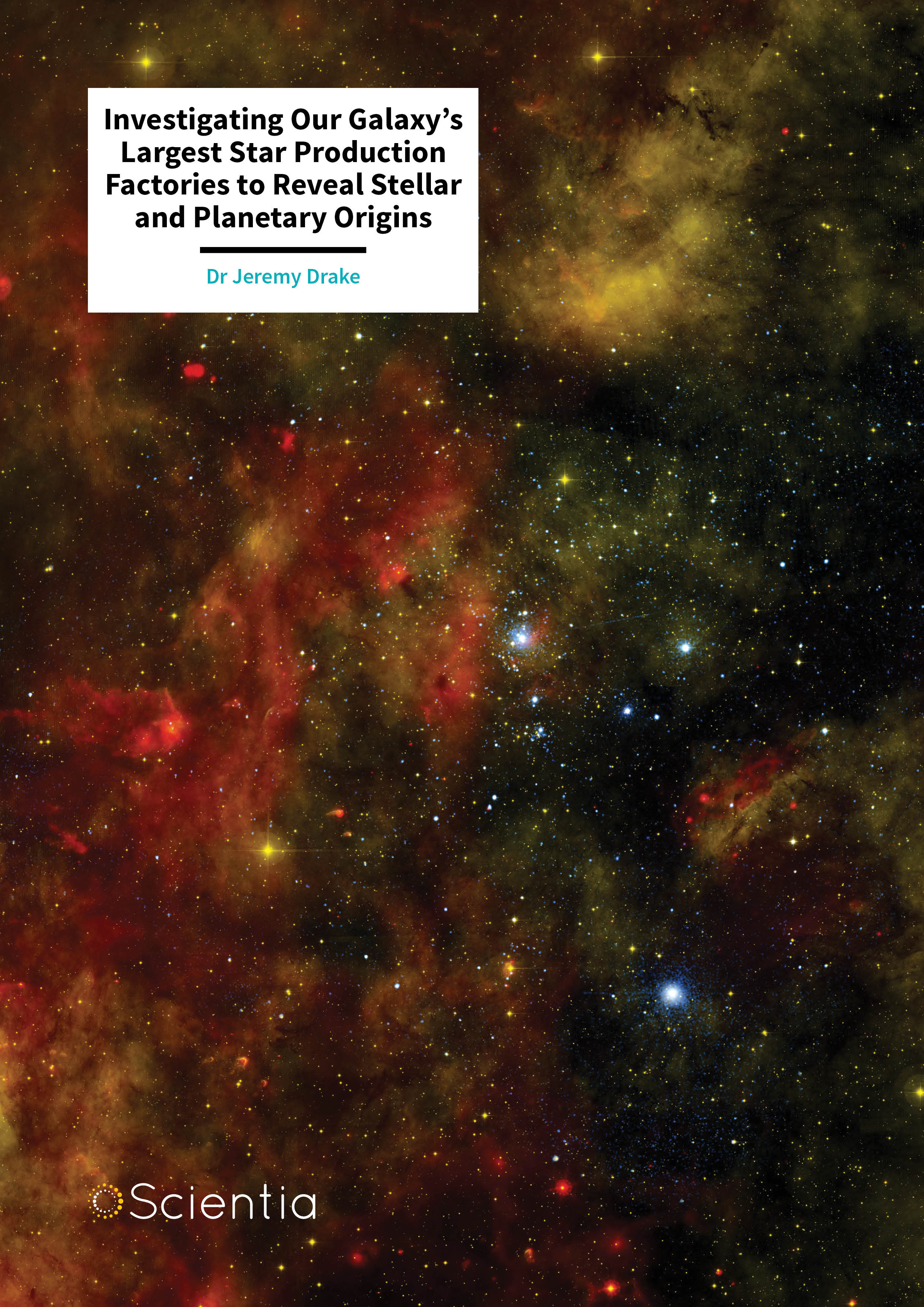Dr Jeremy Drake – Investigating Our Galaxy’s Largest Star Production Factories to Reveal Stellar and Planetary Origins
Star forming regions are dense complexes of young and newly forming stellar clusters, which drive the evolution of galaxies. Dr Jeremy Drake, a Senior Astrophysicist at the Smithsonian Astrophysical Observatory, and his collaborators analyse X-ray, optical and infrared radiation emitted from these star production factories to assay their contents and probe the physics of star and planet formation.
Star forming regions (SFRs) are highly active regions of galaxies, and are made up of between a hundred and millions of young stars. In more massive regions, supernova explosions occur – the violent death throes of massive stars – causing matter to be energetically expelled across the region and into the larger host galaxy. Stellar winds generated by newly formed massive stars also inject matter and energy into SFRs and beyond. These regions of the cosmos are therefore crucial places to understand, driving galaxy evolution and giving birth to all the stars and planets in the Universe.
Typical methods for studying very young stars involve the detection of infra-red (IR) and visible light, using Earth-based telescopes. However, these types of radiation cannot penetrate through the dense interstellar gas and dust clouds often found in and around SFRs, or separate out the young stars from the myriad foreground and background objects. To enable the visualisation of star clusters that are hidden within these clouds, scientists have hit on their X-ray properties as powerful tracers. Very young stars have much more energetic magnetic dynamos than older stars like the Sun, and this magnetism generates extreme heat at the stellar surface that radiates as X-rays.
X-ray emissions cannot be detected using terrestrial telescopes, as they are filtered out by the Earth’s atmosphere. To circumvent this problem, scientists use NASA’s Chandra X-ray Observatory – a telescope that orbits almost 140,000 kilometres above the Earth’s atmosphere. Chandra has been specifically designed to distinguish and detect the X-ray emission from energetic cosmic sources, including young stars, supermassive black holes, and the diffuse X-rays from high-energy astronomical events, such as supernova.
One large SFR of particular interest is the Cygnus X complex, a region made up of hundreds of thousands of young stars lying 4,600 light years from Earth. The central region within the Cygnus-X complex is called Cygnus OB2 – a so-called ‘OB association’, as it contains many O- and B-type stars. O-type stars are between 15 and 100 times the mass of our Sun, and have surface temperatures of between 30,000 and 55,000°C (the Sun, by comparison, has a surface temperature of around 5,500°C). B-type stars are smaller, at 2–16 times the mass of our Sun, with surface temperatures ranging between 10,000 and 30,000°C.
 The high-energy radiation emitted from these O- and B-type stars is believed to trigger the formation of new stars, by ionising nearby dust clouds, compressing them and causing them to collapse. Another way that these massive stars might trigger star formation is when they die, in supernova explosions, and the resulting shockwaves may cause clouds to compress and collapse.
The high-energy radiation emitted from these O- and B-type stars is believed to trigger the formation of new stars, by ionising nearby dust clouds, compressing them and causing them to collapse. Another way that these massive stars might trigger star formation is when they die, in supernova explosions, and the resulting shockwaves may cause clouds to compress and collapse.
As one of the largest SFRs visible from the northern hemisphere, and the closest truly massive SFR, Cygnus OB2 offers a plethora of information on the processes behind star and planet formation. However, the region is concealed behind a large blanket of dust, referred to as the Cygnus Rift. This restricts our ability to visualise and analyse the hidden star cluster using classical IR and visible light observations.
Dr Drake and his international team of astronomers use X-rays to unveil the hidden young stars of Cygnus OB2, allowing them to be studied in more detail. When asked what initially drew him to this field of research, Dr Drake describes that he became fascinated by how ‘a comparatively minor aspect of the workings of a star – its magnetic dynamo and related X-ray emission – draws together such diverse aspects of astrophysics and ultimately has a strong bearing on something as profoundly important as planet formation and evolution, and the origin and evolution of life’.

Surveying Cygnus OB2 with the Chandra X-ray Observatory
The Chandra Cygnus OB2 Survey is an imaging spectroscopy project undertaken using the Advanced CCD Imaging Spectrometer – an instrument capable of measuring both the energy and position of incoming X-rays, housed on board the Chandra X-ray Observatory. Alongside his colleagues, Dr Drake analyses data from this survey, in the hope of answering key questions about the formation, growth and clustering mechanisms of stars in SFRs.
The Cygnus X region is known to have formed following the gravitational collapse of a giant molecular cloud. Models simulating this suggest that following the collapse, an initial burst of star formation occurs. The subsequent perturbation of gas clouds can then cause further waves of star formation. Scientists had previously estimated that the central region of Cygnus OB2 was two million years old, but Dr Nick Wright from Keele University, a member of Dr Drake’s team, uncovered evidence that supports the presence of regions at least five million years old that are likely to have led the initial star formation. The Chandra survey allows researchers to create false-colour stellar density diagrams, where the age variation across different regions can be visualised as a colour gradient. Dr Drake and his team use these results to reconstruct how the star formation in Cygnus OB2 might have proceeded.
Another aim of the Chandra survey is to uncover the statistical distribution of stars with different masses, to probe the origins of massive star formation. Currently, there are two proposed mechanisms by which a massive star can form – either following a large gravitational collapse event as described above, or during ultra-dense clustering of newly forming stars during which objects can gravitationally merge to gain more and more mass. The team is also using data from Chandra to map the mass surface density of stars within Cygnus OB2 to understand if this SFR is undergoing an evolutionary clustering process, or if the region is continuously expanding. They found that, unlike other massive SFRs studied to date, Cygnus OB2 was never a gravitationally-bound region and has always been a loose association.
 Probing Protoplanetary Disks and Circumstellar Envelopes
Probing Protoplanetary Disks and Circumstellar Envelopes
Most stars in the Universe are formed in stellar clusters within larger structures such as an OB association – our own solar system was probably formed in such a region. The energy of the radiation emitted from the massive O- and B-type stars in such an association can have a profound effect not only on the star formation process itself, but also on the evolution of protoplanetary disks – rings comprising solid and gaseous matter that surround a newly-formed star. One major puzzle is whether this exposure can cause significant gaseous photoevaporation – a process where the high-energy radiation dissipates the gas in the disk, potentially preventing planets from forming.
Using Chandra, team member Dr Mario Guarcello from the Palermo Astronomical Observatory identified the proportion of young Sun-like stars that still possess a protoplanetary disk in Cygnus OB2. The team found that protoplanetary disks were more depleted in regions of intense UV emission. In particular, they measured a greater level of depletion near O stars in regions of intense high-energy UV radiation. Owing to its massive stellar content, the intense UV radiation fields make Cygnus OB2 a hostile environment for protoplanetary disks.
A young star, its protoplanetary disk and any remaining circumstellar envelope of gas remaining from its formation each possess a unique spectroscopic signature (a specific pattern of radiation of different energies). By measuring the signatures of the radiation emitted from different stellar sources, Dr Drake’s team categorised each one to describe the evolutionary progress of their protoplanetary disk and envelope. The majority of stars have no disks or envelopes left at all. Of those with some remaining circumstellar material, they found that most possess partially or completely depleted envelopes but have complete inner disks. The team also discovered that a small proportion of stars possess disks that are still growing.
After identifying the evolutionary progress of protoplanetary disks along with their location in the region, the team were then able to trace some of the region’s history. The stars clustered to the centre tended to be bereft of disks and circumstellar gas, but are surrounded by an annular over-density of protoplanetary disks. They found smaller localised regions containing recently formed stars in the outer vicinity of Cygnus OB2. The team could conclude from these findings that OB associations do indeed trigger star formation.

A Region Bathed in X-Rays
Identifying the sources and processes that lead to the emission of X-ray radiation is complex, with multiple competing processes all contributing to the X-rays picked up by the detector.
Diffuse X-ray radiation is theoretically expected in SFRs because massive stars drive streams of charged particles that get heated to millions of degrees in turbulent collisions. Using the mosaic of Chandra X-ray observations, team member Dr Facundo Albacete-Colombo from the Universidad Nacional de Río Negro in Argentina constructed a map of the diffuse X-ray signal. The map revealed the large-scale diffuse emission from powerful stellar winds as predicted, and the interactions of these winds with the interstellar medium. As a bonus, the team discovered that evolved massive stars can produce bright halo-like X-ray diffuse emission structures that had never been seen before.
Future Work
The European Space Agency’s Gaia satellite is currently mapping the galaxy and will provide additional information on the 3D positions and movements of stars within the Cygnus OB2 region of the Cygnus X complex. Once stellar motion has been resolved, the mechanisms underlying the formation of the stellar association and its various sub-clusters should become more apparent. ‘This will give us important clues for how the region and its stars formed, and allow us to predict its future,’ says Dr Wright, thus enabling the team to make accurate predictions on the future evolution of the region. ‘Observations from the ground by the Atacama Large Millimeter Array should also give us new key insights into the evolution of the protoplanetary disks in the Association, and a greater understanding of planet formation in the more violent parts of the Universe,’ adds Dr Drake.
Dr Drake’s team has revealed some of the best-kept secrets of the Universe’s most violent regions. Detecting and analysing X-ray radiation has allowed the team to visualise hidden young stars within our galaxy, bringing to light some of the more elusive aspects of star and planet formation.
Meet the researchers

Dr Jeremy Drake
Dr Jeremy Drake graduated with a D.Phil degree from Oxford University, and was subsequently awarded a NATO Postdoctoral Fellowship to work at the University of Texas, USA. A further postdoctoral term and then staff scientist position at the University of California, Berkeley, was followed by a move to the Smithsonian Astrophysical Observatory to work on NASA’s Chandra X-ray Observatory. Dr Drake’s research interests include the high-energy aspects of star and planet formation, stellar evolution, and planetary radiation environments.

Dr Nick Wright
Dr Nick Wright obtained a PhD from University College London before taking up a research position at the Harvard-Smithsonian Centre for Astrophysics in Cambridge, Massachusetts, and then a Royal Astronomical Society fellowship at the University of Hertfordshire, UK. He is currently an Ernest Rutherford Fellow at Keele University, UK, where he studies the structure and dynamics of star forming regions and young star clusters.

Dr Juan Facundo Albacete Colombo
Dr Juan Facundo Albacete Colombo obtained a PhD from the University of La Plata (Argentina) and subsequently was a Marie Curie post-Doctoral Fellow at the Osservatorio Astronomico di Palermo (Italy). Since 2007, he has been a staff member of the National Council of Research (CONICET) at the University of Rio Negro in Argentina. His studies mainly focus on the X-ray properties of young low mass and high-mass stars in Galactic star forming regions and their impacts on the local interstellar medium. If he ever hangs up the astrophysics gloves, he will be a sailor.

Dr Vinay Kashyap
Dr Vinay Kashyap obtained a PhD in Astronomy & Astrophysics at the University of Chicago. He subsequently carried out postdoctoral research there and later at the Smithsonian Astrophysical Observatory in Cambridge, Massachusetts. He is currently an Astrophysicist at the SAO, where he studies solar and stellar coronal plasma and astro-statistical techniques. He is also a Calibration Scientist at the Chandra X-ray Center, working on the X-ray imaging capabilities of the Chandra X-ray Observatory.

Dr Mario Guarcello
Dr Mario Giuseppe Guarcello obtained his PhD in physics at the University of Palermo, Italy, with a thesis on the star formation in the Eagle Nebula. In 2010 he moved to Cambridge, Massachusetts, USA, as a Postdoctoral Research Fellow at the Harvard-Smithsonian Center for Astrophysics for a collaboration on the Chandra Cygnus OB2 Legacy Project. He is currently a postdoctoral researcher at the INAF – Osservatorio Astronomico di Palermo. His research is mainly focused on star formation and star forming regions, the evolution of protoplanetary disks, and the properties and variability in pre-Main Sequence stars.

Dr Ettore Flaccomio
Dr Ettore Flaccomio obtained a PhD in physics at the University of Palermo in Italy, with a thesis on the X-ray activity of young Pre-Main Sequence stars. During the course of his research he has spent extended periods as a visiting scientist at the Smithsonian Astrophysical Observatory in Cambridge, Massachusetts. He currently holds an Astronomer position at the Italian ‘Instituto Nazionale di Astrofisica’ (INAF), working at the Observatory of Palermo. His main scientific interests are the formation and early evolution of young stars with particular reference to the relation between magnetic activity, mass accretion, and circumstellar disks.

